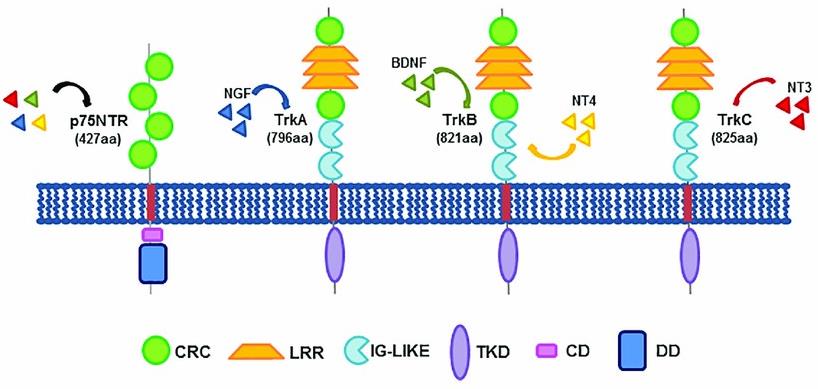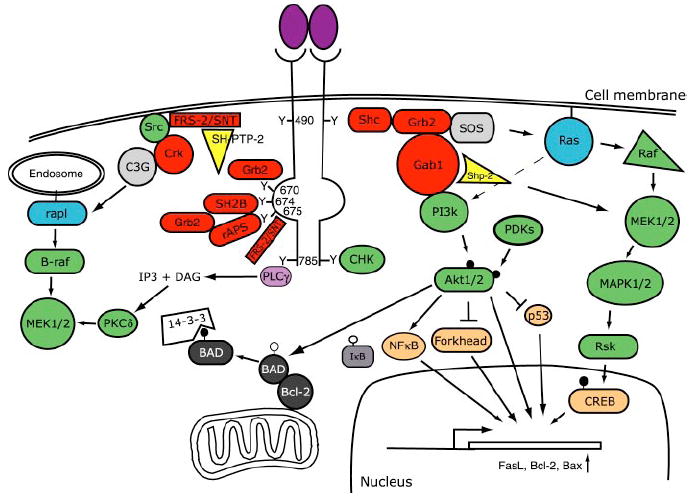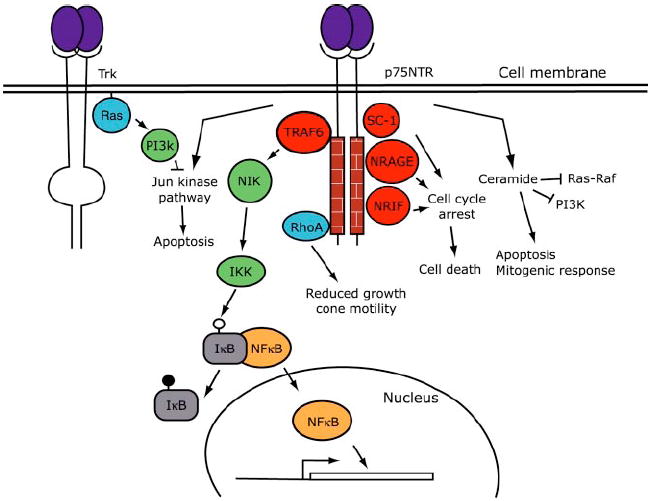Neurotrophin Receptor
Related Symbol Search List
Immunology Background
Available Resources for Neurotrophin Receptor Research
At Creative BioMart, we are proud to offer a diverse range of products related to the neurotrophin receptor. Our extensive selection includes recombinant proteins, protein pre-coupled magnetic beads, cell and tissue lysates, chromatography reagents, and other essential products. These products are carefully curated to support various research needs. Additionally, our customized services are tailored to meet your specific requirements, ensuring that you obtain the exact product you need for your experiments.
In addition to our comprehensive product offerings and services, we provide a wealth of resources for your reference. Our resources cover all aspects related to the neurotrophin receptor, encompassing important details such as involved pathways, protein function, interacting proteins, related articles, research areas, and other relevant topics. These resources serve as invaluable references, empowering researchers to deepen their understanding of the neurotrophin receptor and its crucial role in physiological processes.
Our Featured Products
| Cat.# | Product name | Species | Source (Host) | Tag |
|---|---|---|---|---|
| NTRK1-973H | Active Recombinant Human NTRK1, His tagged | Human | E.coli | His |
| NTRK1-415MF | Recombinant Mouse Ntrk1 Protein, His-tagged, FITC conjugated | Mouse | HEK293 | His |
| Ntrk1-44RAF488 | Recombinant Rat Ntrk1 Protein, Fc-tagged, Alexa Fluor 488 conjugated | Rat | HEK293 | Fc |
| NTRK1-295CAF647 | Recombinant Canine NTRK1 Protein, His-tagged, Alexa Fluor 647 conjugated | Dog | HEK293 | His |
| NTRK2-158H | Recombinant Human NTRK2, Fc-His tagged | Human | Human Cell | Fc/His |
| NTRK3-160H | Active Recombinant Human NTRK3, His-tagged | Human | HEK293 | His |
| NTRK3-159HF | Recombinant Human NTRK3 Protein, Fc/His-tagged, FITC conjugated | Human | HEK293 | Fc/His |
| NTRK3-1388H | Recombinant Human NTRK3, GST-tagged | Human | E.coli | GST |
About Neurotrophin Receptor
Neurotrophin receptors are a group of transmembrane proteins that play a crucial role in mediating the effects of neurotrophins, a family of growth factors involved in the development, survival, and function of neurons. The two primary neurotrophin receptors are Trk (Tropomyosin receptor kinase) receptors and p75NTR (p75 neurotrophin receptor).
Trk Receptors
- TrkA: This receptor is specific for nerve growth factor (NGF). It is primarily expressed in sensory neurons and is involved in the development and maintenance of sensory neurons, as well as pain perception.
- TrkB: This receptor binds to brain-derived neurotrophic factor (BDNF), neurotrophin-4 (NT-4), and neurotrophin-3 (NT-3). TrkB is widely expressed in the central nervous system and peripheral nervous system and plays a role in the survival, differentiation, and synaptic plasticity of various neuronal populations.
- TrkC: This receptor specifically interacts with neurotrophin-3 (NT-3) and is involved in the development and maintenance of proprioceptive sensory neurons and sympathetic neurons.
Activation of Trk receptors by their respective neurotrophin ligands leads to receptor dimerization and autophosphorylation of specific tyrosine residues in the intracellular domain. This triggers downstream signaling pathways, including the Ras-MAPK, PI3K-Akt, and PLCγ pathways, which regulate various cellular processes such as cell survival, differentiation, and synaptic plasticity.
p75NTR
- p75NTR is a low-affinity receptor that can bind to all neurotrophins (NGF, BDNF, NT-3, NT-4). It is widely expressed in the developing and adult nervous system. p75NTR can interact with Trk receptors to modulate their signaling activity or can activate specific signaling pathways independently. The signaling pathways activated by p75NTR are diverse and context-dependent, including those involved in cell survival, apoptosis, axon growth, and synaptic plasticity.
p75NTR can act as a co-receptor with Trk receptors, enhancing or modulating their signaling activity. It can also function as a death receptor, promoting apoptosis or neuronal degeneration in certain conditions. The role of p75NTR is complex and can vary depending on the cellular context, the presence of specific neurotrophin ligands, and the interaction with other signaling molecules.
The neurotrophin receptor system plays a critical role in the development, survival, and function of neurons. Dysregulation of neurotrophin signaling or alterations in the expression and activation of neurotrophin receptors have been implicated in various neurological disorders, including neurodegenerative diseases, mood disorders, and neuropathic pain. Understanding the mechanisms underlying neurotrophin receptor signaling is crucial for unraveling the pathophysiology of these disorders and for developing targeted therapeutic interventions.
 Fig.1 Neurotrophin receptors and their structure. (Licitra F, et al., 2022)
Fig.1 Neurotrophin receptors and their structure. (Licitra F, et al., 2022)
The three members of the Trk family share a common structure, encompassing a cysteine-rich cluster (CRC), three leucine-rich repeats (LRR), a second cysteine cluster and two immunoglobulin-like domains (IG-Like), responsible for ligand binding, in their extracellular domains. A transmembrane domain (TMD) anchors the receptor to the plasma membrane. The intracellular region consists of the tyrosine kinase domain (TKD). On the left, the low-affinity neurotrophin receptor, p75NTR (called NGFR) is also depicted. It consists of four cysteine-rich clusters in the extracellular domain, a transmembrane region and an intracellular region exhibiting a chopper domain (CD) and a death domain (DD). Shown beside each Trk member is reported the corresponding high-affinity binding neurotrophin. p75NTR might bind all neurotrophins at low affinity.
Signaling Mechanisms of the Neurotrophin Receptor
The signaling mechanisms of neurotrophin receptors, particularly the Trk receptors and p75NTR, involve complex intracellular cascades that regulate various cellular processes. Here is an overview of the signaling pathways associated with neurotrophin receptors:
Trk Receptors
- Activation of Trk receptors by neurotrophin binding leads to receptor dimerization and autophosphorylation of specific tyrosine residues in the intracellular domain.
- Phosphorylated tyrosine residues serve as docking sites for various signaling proteins, which initiate downstream signaling pathways.
- The main signaling pathways activated by Trk receptors include:
- Ras-MAPK pathway: Phosphorylated Trk receptors recruit and activate proteins that initiate a cascade of events leading to the activation of Ras and subsequent activation of the MAPK (mitogen-activated protein kinase) pathway. This pathway regulates cell proliferation, survival, and differentiation.
- PI3K-Akt pathway: Phosphorylated Trk receptors also activate phosphoinositide 3-kinase (PI3K), which generates phosphatidylinositol-3,4,5-trisphosphate (PIP3). PIP3 recruits and activates Akt (protein kinase B), leading to the regulation of cell survival, growth, and metabolism.
- PLCγ pathway: Phosphorylated Trk receptors recruit and activate phospholipase Cγ (PLCγ), which generates inositol trisphosphate (IP3) and diacylglycerol (DAG). IP3 triggers the release of calcium ions from intracellular stores, while DAG activates protein kinase C (PKC). These events play a role in neuronal development, synaptic plasticity, and gene expression.
 Fig.2 Schematic diagram of Trk receptor-mediated signal transduction pathways. (Huang EJ, et al., 2001)
Fig.2 Schematic diagram of Trk receptor-mediated signal transduction pathways. (Huang EJ, et al., 2001)
p75NTR
p75NTR can mediate both ligand-dependent and ligand-independent signaling.
- Ligand-dependent signaling
The binding of neurotrophins to p75NTR can enhance or modulate the signaling activity of Trk receptors. This co-receptor function can potentiate or modify the downstream signaling cascades initiated by Trk receptors. For example, p75NTR can promote the internalization and trafficking of Trk receptors, leading to sustained or enhanced activation of Trk signaling pathways.
- Ligand-independent signaling
- p75NTR can activate specific signaling pathways independently of Trk receptors.
- The signaling pathways activated by p75NTR are diverse and context-dependent, and they can include both pro-survival and pro-apoptotic pathways.
- Examples of downstream signaling pathways include the NF-κB (nuclear factor kappa-light-chain-enhancer of activated B cells) pathway, JNK (c-Jun N-terminal kinase) pathway, and Rho GTPase pathway, which regulate processes such as cell survival, apoptosis, axon growth, and synaptic plasticity.
 Fig.3 Schematic diagram of p75NTR-mediated signal transduction pathways. (Huang EJ, et al., 2001)
Fig.3 Schematic diagram of p75NTR-mediated signal transduction pathways. (Huang EJ, et al., 2001)
It is important to note that the signaling mechanisms of neurotrophin receptors are highly complex and can be influenced by multiple factors, including the specific neurotrophin ligands, receptor expression levels, and the cellular context. The interplay between Trk receptors and p75NTR adds another layer of complexity to the signaling outcomes. Further research is needed to fully elucidate the precise mechanisms underlying neurotrophin receptor signaling and its implications in neurodevelopmental processes and neurological disorders.
If you have any questions, requirements, or cooperation intentions, please feel free to contact us. We very much look forward to working with you and helping you achieve research and commercial success.
References:
- Licitra F, Giovannelli P, Di Donato M, et al. New insights and emerging therapeutic approaches in prostate cancer[J]. Frontiers in Endocrinology, 2022, 13: 840787.
- Kraemer B R, Yoon S O, Carter B D. The biological functions and signaling mechanisms of the p75 neurotrophin receptor[J]. Neurotrophic Factors, 2014: 121-164.
- Khodorova A, Nicol G D, Strichartz G. The TrkA receptor mediates experimental thermal hyperalgesia produced by nerve growth factor: Modulation by the p75 neurotrophin receptor[J]. Neuroence, 2017, 340:384.
- Huang EJ, Reichardt LF. Neurotrophins: roles in neuronal development and function. Annu Rev Neurosci. 2001;24:677-736.

